3 days in Lisbon + 1 day
All Days
Day 1
Day 2
Day 3
Day 4
Day 1
1. Observation Deck Park Eduardo VII

The Observation Deck at Parque Eduardo VII in Lisbon offers one of the best panoramic views of the city. Located at the top of the park, this viewpoint gives you a breathtaking view of the symmetrical gardens, the grand Avenida da Liberdade, and all the way down to the Tagus River.
Parque Eduardo VII is Lisbon’s largest central park, filled with green lawns, walking paths, and sculptures. At the very top, near the flag monument, you’ll find the Miradouro do Parque Eduardo VII, the perfect spot to sit, relax, and enjoy the scenery.
This viewpoint is especially stunning at sunrise or sunset, when the city is bathed in golden light. It’s a great place to take photos, go for a walk, or just appreciate Lisbon’s beauty from above.

2. Marques De Pombal

The Marquês de Pombal Square (Praça Marquês de Pombal) is one of Lisbon’s most important landmarks. Located at the end of Avenida da Liberdade, it serves as a central transport hub and a gateway to the city's modern areas.
At the center of the square stands a tall monument dedicated to Marquês de Pombal, the prime minister who rebuilt Lisbon after the 1755 earthquake. The statue shows him standing proudly, with a lion at his side, symbolizing his strength and leadership.
Surrounding the square are major hotels, offices, and shops, making it a busy and important area for both locals and visitors. It also connects to Parque Eduardo VII, where you can enjoy beautiful green spaces and city views.

3. Av. da Liberdade
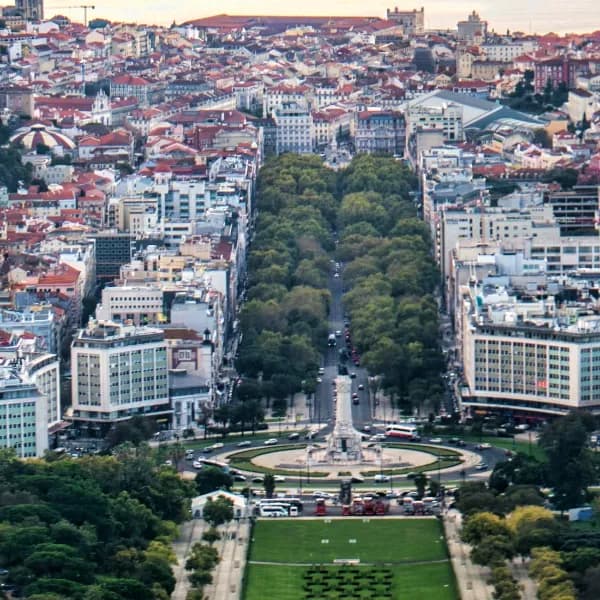
Avenida da Liberdade is Lisbon’s most elegant and famous avenue, stretching 1.5 km from Marquês de Pombal Square to Restauradores Square. Known for its luxury shops, historic buildings, and tree-lined sidewalks, it’s often compared to Champs-Élysées in Paris.
Walking along the avenue, you’ll find high-end fashion brands like Gucci, Prada, and Louis Vuitton, as well as theaters, cafés, and historic hotels. The wide sidewalks, decorated with traditional Portuguese pavement (calçada portuguesa), make it a great place for a relaxing stroll.
Besides shopping, Avenida da Liberdade is also rich in history. Many of its buildings date back to the 19th and early 20th centuries, giving it a unique mix of old-world charm and modern luxury. The avenue is also home to several monuments, fountains, and gardens, making it a beautiful place to explore.

4. Glória Funicular

The Glória Funicular (Elevador da Glória) is one of Lisbon’s most charming and historic transport systems. It connects the Avenida da Liberdade area to the Bairro Alto neighborhood, offering a fun and unique way to experience the city’s steep hills.
Built in 1885, the funicular has become a beloved symbol of Lisbon’s historic public transport. The journey is short, but it’s a beautiful ride with views of the city’s streets, colorful buildings, and vibrant neighborhoods. As the funicular climbs the hill, you’ll pass through the tree-lined streets of Praça dos Restauradores before reaching the top at Bairro Alto, known for its lively nightlife and famous viewpoints.
The Glória Funicular is not just a way to get from one place to another—it's a step back in time, as it has preserved its old-fashioned charm and remains a popular tourist attraction.

5. Miradouro de São Pedro de Alcântara
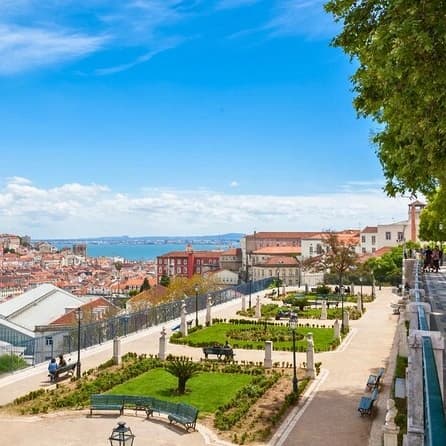
The Miradouro de São Pedro de Alcântara is a stunning viewpoint in Lisbon, offering breathtaking views of the city. From here, you can admire the São Jorge Castle, the Baixa district, and the Tagus River. Located in the vibrant Bairro Alto neighborhood, this spot is a favorite for both locals and visitors.
The viewpoint is surrounded by charming gardens, statues, and benches, making it a peaceful place to relax and enjoy the view. It’s perfect for taking in the cityscape during the day, or for watching the city come to life at sunset and evening.
You can easily reach the Miradouro de São Pedro de Alcântara by riding the historic Glória Funicular, a fun and scenic tram ride that takes you up the hill while offering fantastic views of Lisbon along the way.

6. Praça Dom Pedro IV

Praça Dom Pedro IV, also known as Rossio Square, is one of the most famous and lively squares in Lisbon. Located in the heart of the city, it has been an important meeting point for locals and visitors for centuries.
The square is named after Dom Pedro IV, the king of Portugal, and features a large statue of him at the center. The fountain, historic buildings, and cobblestone paving give the square a charming and vibrant atmosphere. It’s a popular spot to relax, people-watch, or take in the surrounding sights.
Surrounding Praça Dom Pedro IV are some of Lisbon's iconic landmarks, such as the Teatro Nacional Dona Maria II and the Estação do Rossio, a beautiful train station. The square also connects to Rua Augusta, one of Lisbon’s busiest shopping streets, making it a great spot to start exploring the city.

7. Santa Justa Lift

The Santa Justa Lift (Elevador de Santa Justa) is one of Lisbon's most iconic landmarks. This historic elevator, built in 1902, connects the Baixa district with the Carmo Square and Bairro Alto, helping visitors navigate the city’s steep hills.
The lift is a beautiful piece of architecture, designed in a neo-Gothic style with intricate ironwork. It stands 45 meters tall, offering a fantastic view of Lisbon’s skyline, including landmarks like the São Jorge Castle and the Baixa district. At the top, there's a viewing platform where you can enjoy the stunning scenery of the city.
The Santa Justa Lift is not just a convenient way to move between different parts of the city, but also an attraction in itself. It's especially popular with tourists, as it provides a unique perspective of Lisbon's historic areas.

8. Carmo Archaeological Museum
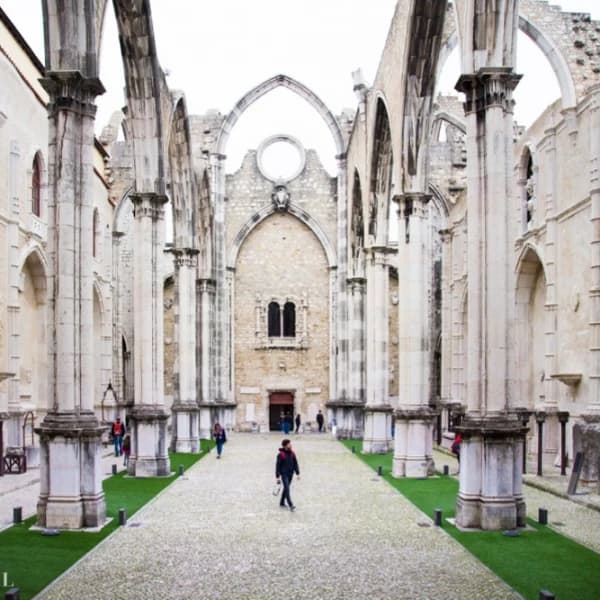
You can easily reach the Carmo Archaeological Museum (Museu Arqueológico do Carmo) by taking the Santa Justa Lift, which connects the Baixa district to Carmo Square. Once you’re at the top, the museum is just a short walk away, nestled within the Carmo Convent.
The museum offers visitors a fascinating look at Lisbon's rich history, housed in the ruins of the Carmo Convent, which was built in the 14th century but was left in ruins after the 1755 earthquake. The stunning, roofless structure adds a unique atmosphere to the museum.
Inside, you'll find a remarkable collection of archaeological artifacts, including Roman sculptures, medieval tombs, Islamic ceramics, and items from Portugal’s colonial past. The museum traces the history of Lisbon and Portugal, with objects spanning from prehistoric times to the Middle Ages.
The Carmo Archaeological Museum is not just an important cultural site but also an architectural gem. The gothic arches and the ruins of the convent create a stunning setting for the museum’s exhibits, making it a must-see for anyone interested in Lisbon’s history.

9. Manteigaria - Cream Pastry Factory

Manteigaria is a famous cream pastry factory in Lisbon, known for its delicious pastéis de nata, the traditional Portuguese custard tarts. Located in the Baixa district, Manteigaria is a must-visit spot for anyone looking to try one of Lisbon’s most beloved treats.
The pastéis de nata at Manteigaria are freshly baked every day, with a golden, crispy pastry shell and a smooth, creamy custard filling. They’re served warm, dusted with a little bit of cinnamon and powdered sugar, making them the perfect snack or dessert. The factory’s open kitchen allows visitors to watch the bakers at work, which adds to the experience.
Manteigaria has built a reputation for offering some of the best pastéis de nata in Lisbon, often compared to the famous Pastéis de Belém. If you're in Lisbon, it's definitely worth stopping by to taste these mouthwatering pastries and enjoy a true taste of Portuguese culture.

10. Rua Augusta

Rua Augusta is one of the most famous streets in Lisbon, located in the heart of the city. It’s a lively and bustling pedestrian street that stretches from Praça do Comércio to Rossio Square. Known for its vibrant atmosphere, it’s a popular destination for both locals and tourists.
The street is lined with a variety of shops, restaurants, cafés, and historical buildings, making it a great place to explore. You can find international brands, as well as traditional Portuguese shops, offering everything from fashion to souvenirs. Along the way, you can enjoy a coffee at one of the many outdoor cafés, people-watch, or simply take in the beauty of the surrounding architectural landmarks.
At the top of Rua Augusta, you’ll find the Arco da Rua Augusta, a grand triumphal arch that offers spectacular views of Lisbon from its viewing platform. The arch is one of the iconic symbols of the city and marks the transition between the Baixa district and Chiado.

11. Arco da Rua Augusta

Arco da Rua Augusta is a magnificent triumphal arch located at the top of Rua Augusta in Lisbon, marking the entrance to the Baixa district. Built to celebrate the reconstruction of the city after the devastating 1755 earthquake, this iconic arch is an architectural masterpiece that blends neoclassical and Baroque styles.
The arch is adorned with impressive sculptures and reliefs that represent various figures from Portuguese history, including Glory, Commerce, and Independence. At the top of the arch, you’ll find a statue of King José I, who ruled Portugal during the time of the earthquake, symbolizing the resilience and rebirth of the city.
Visitors can take an elevator and a short climb to the viewing platform at the top of the arch, where you’re rewarded with panoramic views of Lisbon, including the Tejo River, Praça do Comércio, and the surrounding historic buildings. The view is especially beautiful at sunset, offering a perfect opportunity for photos.
The Arco da Rua Augusta is not just an architectural landmark but also an important part of Lisbon's history. It serves as a symbol of the city’s resilience and its vibrant cultural heritage.

12. Praça do Comércio
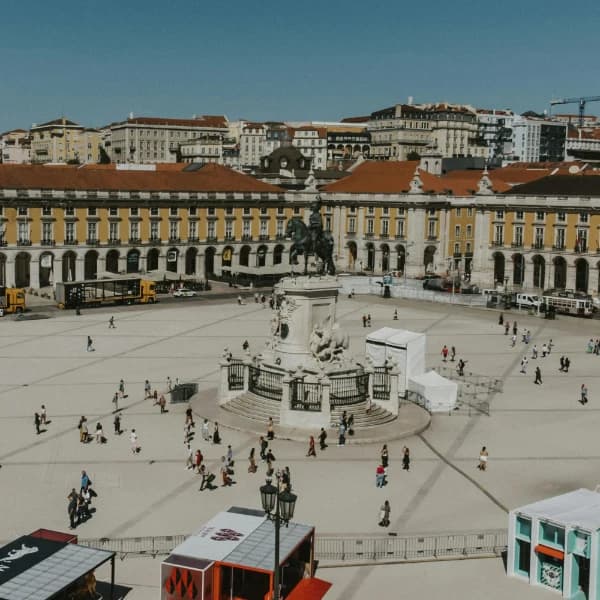
Praça do Comércio, also known as Terreiro do Paço, is one of Lisbon’s most iconic squares. Located by the Tejo River, it is surrounded by stunning yellow buildings with arcades, creating a grand and open space that captures the essence of the city's historic charm.
The square was once the site of the Royal Palace of Lisbon, which was destroyed in the 1755 earthquake. After the earthquake, the square was redesigned and became the center of the city's political and commercial life. Today, it remains a vibrant symbol of Lisbon’s rich history.
In the center of the square stands the statue of King José I, which was erected to honor the king’s role in rebuilding the city after the earthquake. The statue is surrounded by beautiful architecture, including the Arco da Rua Augusta at the north entrance, which leads to the Rua Augusta shopping street.
Praça do Comércio is a popular spot for both locals and tourists. It’s a great place to relax by the river, enjoy a coffee at one of the many cafés, or take in the beautiful views of the river and the 25 de Abril Bridge. The square is also home to several important buildings, including the Museu de História de Lisboa and the Ministry of the Sea.

13. Sé de Lisboa

Sé de Lisboa, also known as the Lisbon Cathedral, is one of the oldest and most important churches in Lisbon, located in the heart of the Alfama district. Built in the 12th century, it stands as a symbol of the city’s history and religious heritage.
The cathedral features a mix of architectural styles, with Romanesque, Gothic, and Baroque influences. Its exterior is imposing, with large, fortress-like towers and a simple yet striking façade. Inside, the cathedral’s interior is equally impressive, with a mysterious and calm atmosphere enhanced by its ancient stone arches, intricate stained glass windows, and beautiful chapels.
One of the key highlights of Sé de Lisboa is the archaeological site beneath the cathedral, where you can explore the remains of previous structures, including a Romanesque church and even a Moorish mosque. Visitors can also take a walk around the cloisters, which offer a peaceful escape from the bustling city.
The cathedral has witnessed many significant moments in Lisbon's history, including the coronation of kings and the wedding of Portuguese royalty. Today, it remains an active place of worship and a popular tourist destination.

14. Tram 28

Tram 28 is one of the most famous and iconic tram routes in Lisbon. It takes passengers on a scenic journey through some of the city’s most historic and charming neighborhoods, offering a great way to explore Lisbon's Alfama, Graça, Baixa, and Bairro Alto districts.
The tram itself is a vintage yellow tram, which has become a symbol of Lisbon. It clatters through narrow, cobblestone streets, past colorful buildings, historic churches, and bustling squares, offering a unique and nostalgic experience. The route covers some of Lisbon’s top attractions, including the Sé de Lisboa (Lisbon Cathedral), Miradouro da Graça, and São Jorge Castle. It is a good way to explore all the historic districts and use it as a transport to go from Sé de Lisboa to Castelo de São Jorge.
Riding Tram 28 is not just about getting from point A to point B – it’s about the journey itself. The tram offers stunning views of the city’s hills, narrow streets, and scenic viewpoints. It’s a great way to get a taste of the old-world charm of Lisbon, especially for those who want to experience the city in a more traditional way.
Although Tram 28 can get crowded, especially during the peak tourist season, it’s still one of the best ways to explore Lisbon’s historic areas while enjoying the sights and sounds of the city.

15. Castelo de São Jorge
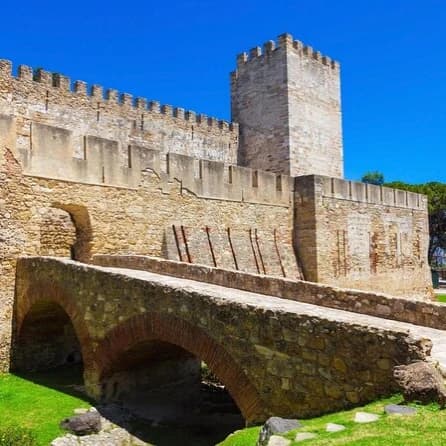
Castelo de São Jorge (St. George’s Castle) is one of Lisbon’s most iconic landmarks, offering spectacular views of the city and a fascinating glimpse into its history. Situated on one of the city's highest hills, the castle has stood since the 11th century and is a symbol of Lisbon’s past.
The castle was originally built by the Moors during their rule over the region but was later expanded and fortified by the Christians after they captured the city in 1147. It played a key role in the defense of the city throughout the centuries and has witnessed many important historical events.
As you walk through the castle’s grounds, you’ll find ancient walls, towers, and courtyards, along with panoramic views of Lisbon’s rooftops, the Tejo River, and the nearby Alfama district. The castle’s viewpoint is one of the best spots to take in the beauty of the city, especially at sunset when the golden light creates a magical atmosphere.
Inside the castle, you can explore several exhibitions that showcase the history of Lisbon, including archaeological artifacts, medieval weapons, and exhibits about the Moors and the Portuguese monarchy. The gardens around the castle are also a peaceful place to relax, with scenic paths and beautiful greenery.

Day 2
1. Belém Tower

Belém Tower (Torre de Belém) is one of Lisbon's most iconic landmarks and a UNESCO World Heritage site. Located along the banks of the Tejo River, this 16th-century fortress was originally built to defend the city from naval attacks and protect the entrance to the harbor. It is an exceptional example of Manueline architecture, a Portuguese style that blends late Gothic elements with maritime motifs.
The tower was commissioned by King Manuel I and completed in 1520. Over the years, it has served various purposes, including as a defensive fortification, a lighthouse, and even a customs post. Its rich history and distinctive design make it a significant symbol of Lisbon's maritime heritage, representing Portugal's age of exploration during the Age of Discoveries.
The tower's most striking features are its ornate stone carvings, including maritime symbols like ropes and anchors, and its turret-like structure with a balcony offering incredible views of the river and surrounding area. Visitors can climb the tower’s narrow stairs to the top and enjoy sweeping views of the Belém district, the Monument to the Discoveries, and the nearby April 25th Bridge.
The interior of Belém Tower is equally fascinating, with historical displays that tell the story of the tower's past and Portugal's role in global exploration. The bastion area, where soldiers once stood guard, is an intriguing part of the experience.

2. Padrão dos Descobrimentos
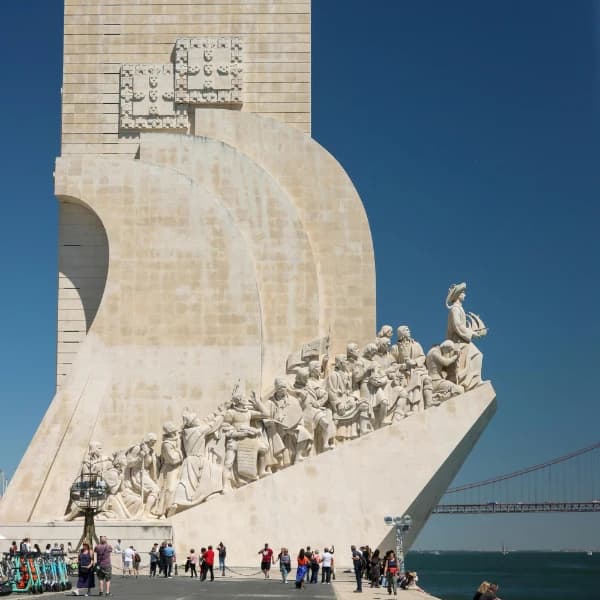
Padrão dos Descobrimentos (Monument to the Discoveries) is a striking landmark in Belém, Lisbon, that honors Portugal’s maritime explorers and the country's significant role in the Age of Discoveries. Standing tall along the banks of the Tejo River, the monument celebrates the adventurous spirit of the Portuguese who sailed to distant lands, opening new trade routes and establishing Portugal’s global empire in the 15th and 16th centuries.
The monument was inaugurated in 1960 to commemorate the 500th anniversary of Prince Henry the Navigator's death. It was designed by the architect José Ângelo Cottinelli Telmo and sculptor Leopoldo de Almeida, and its shape is meant to resemble the bow of a ship, symbolizing Portugal’s maritime history.
The monument stands at 52 meters tall and features statues of key figures in the exploration era, including Vasco da Gama, Fernão Mendes Pinto, Pedro Álvares Cabral, and Magellan. At the base, you’ll find an intricate map of Portugal's explorations, highlighting the routes taken by these famous explorers.
Visitors can take an elevator to the top of the monument, where they are rewarded with stunning panoramic views of the Tejo River, Belém Tower, and the Monastery of Jerónimos. The viewpoint is an excellent spot for photos, and it allows you to appreciate the significance of the monument in the context of the city and the river that played such a key role in Portugal's maritime past.

3. Jerónimos Monastery

Jerónimos Monastery (Mosteiro dos Jerónimos) is a stunning 16th-century landmark in Belém, Lisbon, and a UNESCO World Heritage site. Built to honor Vasco da Gama’s successful voyage to India, it’s a prime example of Manueline architecture, blending Gothic, Renaissance, and maritime designs.
The Church of Santa Maria inside houses the tombs of Vasco da Gama and King Manuel I. The cloisters are peaceful and beautifully adorned with intricate carvings. The monastery is a must-see for its historical significance and breathtaking design, offering a glimpse into Portugal’s maritime past.

4. Church of Saint Mary of Bethlehem

The Church of Saint Mary of Bethlehem (Igreja de Santa Maria de Belém) is part of the Jerónimos Monastery in Lisbon. Built in the early 16th century, it was designed to commemorate Vasco da Gama’s successful journey to India. The church is a beautiful example of Manueline architecture, with intricate stone carvings, large vaulted ceilings, and stunning stained-glass windows.
Inside, you’ll find the tombs of Vasco da Gama and King Manuel I, both key figures in Portugal's Age of Exploration. The church is known for its serene and majestic atmosphere, making it an important site in Lisbon's history and a must-visit for those exploring the Belém district.

5. 25 April Bridge

View to The 25th April Bridge (Ponte 25 de Abril). It is a striking suspension bridge in Lisbon, connecting the city to the municipality of Almada on the other side of the Tejo River. Named after the Portuguese Revolution of April 25, 1974, which overthrew the Estado Novo dictatorship, the bridge is often compared to San Francisco's Golden Gate Bridge due to its similar red color and architectural design.
Opened in 1966, the bridge spans nearly 2.3 kilometers and is a vital part of Lisbon's infrastructure, facilitating both road and rail traffic. The bridge offers incredible views of Lisbon, the river, and the nearby Christ the King statue in Almada.
It’s one of Lisbon’s most iconic landmarks, often photographed and admired for its beauty and engineering. Visitors can also take a boat tour or view the bridge from various miradouros (viewpoints) across the city for a unique perspective.

6. Pink Street

Pink Street (Rua Nova do Carvalho) is one of Lisbon’s most vibrant and trendy areas, known for its distinctive pink-colored pavement that gives it a lively and playful atmosphere. Located in the Cais do Sodré district, it has transformed over the years from a once industrial area to a bustling hub of nightlife, restaurants, and bars.
The street is lined with stylish cafes, cocktail bars, and nightclubs, making it a popular spot for both locals and tourists looking for a fun night out. During the day, Pink Street has a more relaxed vibe, with cafes and shops where you can enjoy a leisurely walk or grab a coffee. As the night falls, the street comes alive with music, people, and a vibrant energy that defines Lisbon’s contemporary nightlife scene.

7. Livraria Bertrand - Chiado
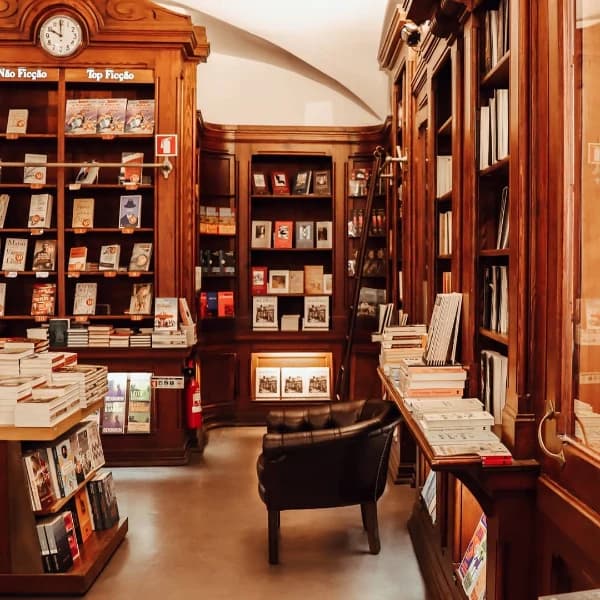
Livraria Bertrand in Chiado is the world’s oldest bookstore, recognized by the Guinness World Records. Established in 1732, it has been a hub for literature lovers in Lisbon for centuries. Located in the vibrant Chiado district, this historic bookstore has preserved its charming atmosphere, combining traditional and modern elements.
The store offers a wide range of books in various genres, including literature, history, and art. The interior is elegant, with wooden shelves that reach up to the high ceilings, making it a cozy and inviting place to browse. It also hosts book launches, readings, and other cultural events, making it an important cultural spot in Lisbon.

8. Palace Fronteira

Palácio Fronteira is a beautiful and historic palace located in Lisbon, Portugal. Built in the 17th century, the palace is an excellent example of Portuguese Baroque architecture. It was originally the residence of the Fronteira family, and today it is open to the public, allowing visitors to explore its stunning interiors and gardens.
One of the palace’s most impressive features is its azulejos (traditional blue-and-white tiles), which decorate the walls and provide a glimpse into Portugal's artistic heritage. The gardens are equally captivating, with lush greenery, fountains, and statues that create a peaceful, almost magical atmosphere.
Palácio Fronteira also houses several art collections, including portraits, tapestries, and furniture, making it an interesting spot for those interested in both history and art. It is a hidden gem in Lisbon, offering visitors a chance to experience the grandeur and elegance of Portugal's past.

Day 3
1. National Palace of Pena

The National Palace of Pena (Palácio Nacional da Pena) is one of Portugal's most iconic landmarks, located in the picturesque town of Sintra, just outside of Lisbon. Built in the 19th century, this palace is a stunning example of Romanticist architecture that blends Gothic, Renaissance, and Manueline styles. The palace sits atop a hill, offering breathtaking views of the surrounding landscape, including the town of Sintra and the lush greenery of the Sintra Mountains.
The palace’s colorful and eclectic design, with vibrant shades of yellow, red, and green, makes it a striking sight. Inside, visitors can explore the royal chambers, chapels, and decorated rooms, each filled with furniture, artwork, and artifacts from the 19th century.
The gardens surrounding the palace are also a highlight, with walking paths, fountains, and exotic plants, providing a serene atmosphere to explore.

2. The Moorish Castle

The Moorish Castle (Castelo dos Mouros) is a historic fortress located in Sintra, Portugal, offering stunning views over the town, the Pena Palace, and the surrounding mountains. Built in the 8th and 9th centuries by the Moors, the castle has a rich history, having been part of the Moorish occupation of the Iberian Peninsula.
The castle is known for its well-preserved walls, towers, and battlements, which visitors can explore as they walk along the ancient walls. The castle's location atop a hill makes it an excellent spot for panoramic views of the Sintra-Cascais Natural Park and the town below.
As you wander through the castle, you can imagine the strategic importance it held during the medieval period. Although much of the castle’s original structure has eroded over time, it still retains a sense of grandeur and mystery.

3. National Palace of Sintra
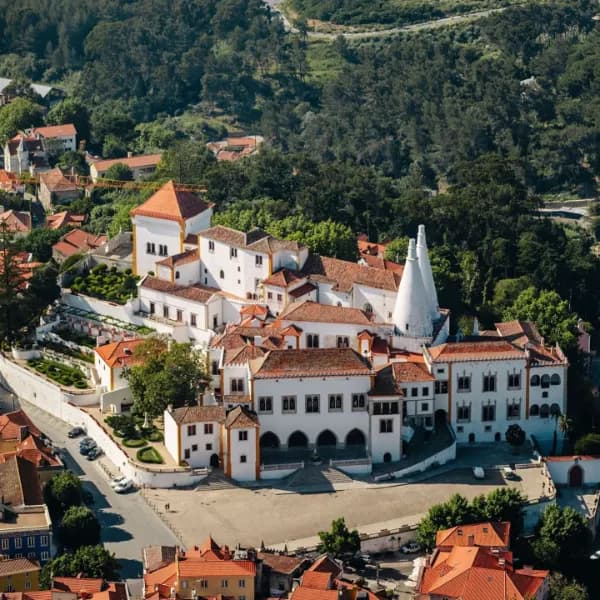
The National Palace of Sintra (Palácio Nacional de Sintra) is a historic royal palace located in the heart of Sintra, Portugal. Known for its striking white and black chimneys, the palace is one of the best-preserved medieval royal residences in Portugal. Its origins date back to the 14th century, and it was expanded and renovated over the centuries by various monarchs.
The palace’s distinctive architecture blends Gothic, Manueline, and Moorish styles, reflecting the different historical periods it has witnessed. Inside, visitors can explore beautifully decorated rooms, including the Swans’ Room, Magpie Room, and the Chapel, each adorned with intricate tilework, colorful murals, and antique furniture.
The palace’s two large chimneys are its most recognizable feature, towering above the town and making it a famous symbol of Sintra. The surrounding gardens and views of the town and nearby hills add to the palace’s charm.

4. Quinta da Regaleira

Quinta da Regaleira is one of the most magical and mysterious places in Sintra, Portugal. Built in the early 20th century by a wealthy businessman, António Augusto Carvalho Monteiro, the estate is a mix of Gothic, Manueline, and Renaissance styles, designed to reflect mystical and esoteric symbols.
The property is best known for its lush gardens, hidden tunnels, lakes, grottoes, and the famous Initiation Well — a deep, spiral staircase that leads underground, believed to have been used for secret initiation ceremonies. Every corner of Quinta da Regaleira is filled with symbols related to alchemy, masonry, and mythology, creating a sense of adventure and mystery as you explore.
The palace itself is beautifully decorated, with intricate stonework, towers, and stunning interiors, but the real magic lies in wandering through the gardens and discovering the secret pathways.

5. Park and Palace of Monserrate
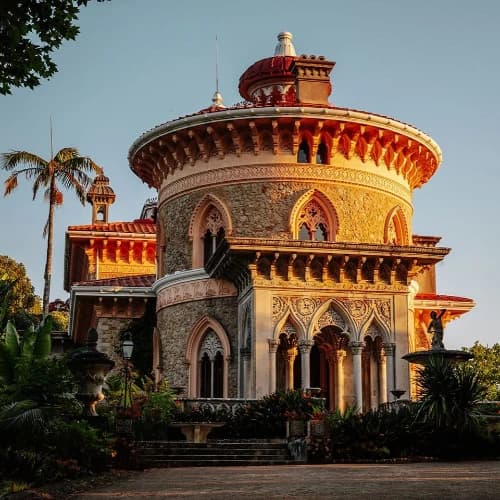
The Park and Palace of Monserrate in Sintra is a beautiful and peaceful place, perfect for exploring nature and history together. The palace was built in the 19th century by Sir Francis Cook and mixes different styles, like Gothic, Moorish, and Indian, making it look very exotic and unique.
Around the palace, there are large gardens filled with plants from all over the world. You can walk through special areas like the Mexican Garden, the Rose Garden, and the Fern Valley, each with its own beautiful plants and paths. The whole park feels magical, with fountains, lakes, and hidden spots to discover.
Visiting the Park and Palace of Monserrate is a wonderful way to enjoy the beauty of Sintra, away from the bigger crowds.

Day 4 - optional
1. Parque das Nações

Parque das Nações is a modern, vibrant district in Lisbon, located along the Tagus River. Developed for the 1998 World Expo, it’s now one of the city’s most dynamic areas, blending contemporary architecture, cultural attractions, and green spaces.
The district is home to several interesting sites, such as the Oceanário de Lisboa, one of the largest aquariums in Europe, and the Vasco da Gama Tower, offering panoramic views of the city. You can also explore the Vasco da Gama Shopping Center or enjoy a relaxing walk along the riverfront promenade.
Parque das Nações is perfect for those who want to enjoy a mix of art, nature, and modern city life.

2. Telecabine Lisbon
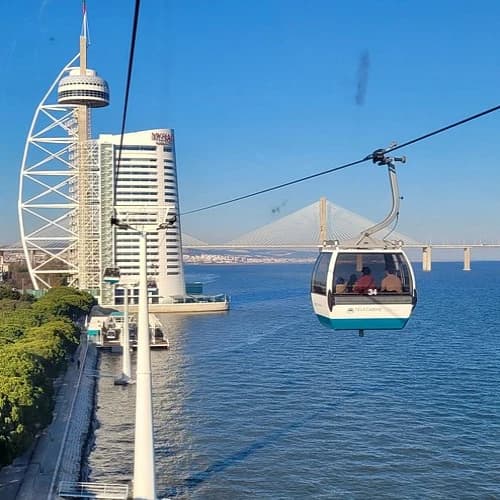
The Telecabine Lisbon is a cable car ride that offers stunning aerial views of the city, located in the Parque das Nações district. It stretches over the Tagus River, providing a unique perspective of the surrounding area, including the Vasco da Gama Bridge, the Vasco da Gama Tower, and the modern architecture of the Expo 98 site.
The ride is approximately 1 kilometer long, and it’s a relaxing way to see some of Lisbon’s most scenic spots from above. The cable cars are comfortable and spacious, with large windows that allow you to fully appreciate the panoramic views.

3. Vasco da Gama Tower Babylon 360
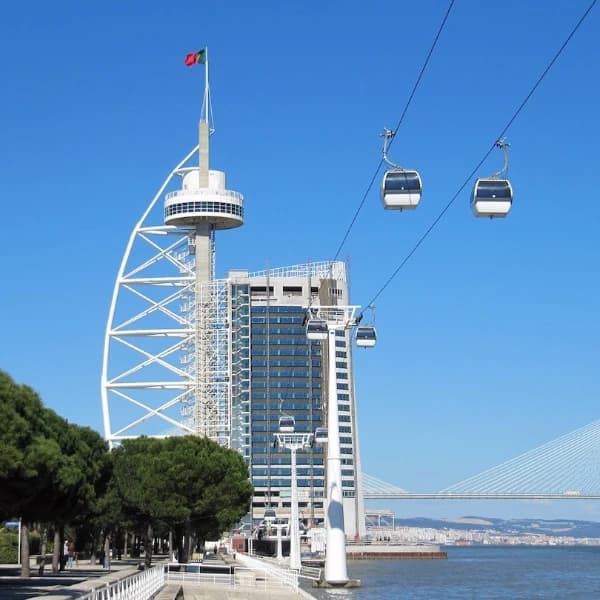
The Vasco da Gama Tower, located in Parque das Nações in Lisbon, is one of the most iconic landmarks in the city. Standing at 140 meters, it was originally built for the 1998 World Expo and has since become a symbol of Lisbon's modern architecture. The tower offers spectacular views over the city, the Tagus River, and the Vasco da Gama Bridge.
One of the highlights of the tower is the Babylon 360 restaurant, located on the top floor. This revolving restaurant offers a 360-degree panoramic view of Lisbon, allowing you to enjoy your meal while watching the city unfold around you. The restaurant offers a variety of international dishes, and the stunning views make it an unforgettable dining experience.

4. Calouste Gulbenkian Museum

The Calouste Gulbenkian Museum is one of Lisbon’s most renowned cultural attractions. Located in the Areeiro district, the museum houses an impressive collection of art, spanning 4,000 years of history. It was founded by Calouste Gulbenkian, a philanthropist and art collector who donated his vast collection to the city.
The museum is divided into two main sections: the Classical Art Collection and the Modern Art Collection. The Classical collection features works from ancient Egypt, Greece, Rome, and the Islamic world, including jewelry, sculptures, and paintings. The Modern Art Collection, on the other hand, includes pieces by famous 20th-century artists such as Rodin, Monet, and Van Dyck.
In addition to the art collections, the museum is set in beautiful gardens, offering a peaceful environment for visitors to explore.



